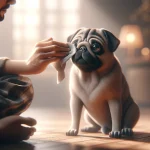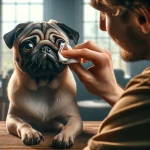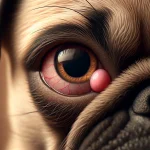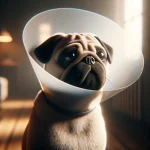Table of Contents
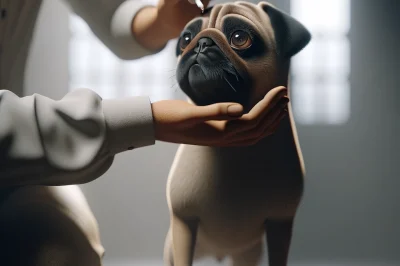
Article-at-a-Glance
- Discover the unique eye care needs of Pugs and how to meet them.
- Learn how to select the best artificial tears to keep your Pug’s eyes healthy.
- Get a step-by-step guide on daily eye maintenance for your Pug.
- Understand common eye problems in Pugs and when to seek veterinary help.
- Explore the importance of nutrition and regular check-ups for your Pug’s eye health.
As the owner of a Pug, you know that those big, expressive eyes are part of what makes your furry friend so endearing. However, those same adorable eyes are also prone to various health issues. That’s why understanding and practicing proper eye care is essential for keeping your Pug’s peepers in tip-top shape. Let’s dive into the world of Pug eye care, and equip you with the knowledge you need to ensure your pooch’s vision stays sharp and clear.
Pug Eye Health: Preventative Care Starts Here
Pugs have a distinctive face with deep wrinkles and large, round eyes. These features, while cute, can lead to specific eye problems like proptosis, where the eye may dislocate from the socket, or entropion, where the eyelids roll inward. Preventative care is key. By keeping their eyes clean and monitoring for any signs of discomfort or disease, you can help prevent or catch issues early when they’re most treatable.
Understanding Pug Eyes: Unique Needs and Care
Pugs are brachycephalic, meaning they have a short nose and flat face. This anatomy puts them at a higher risk for eye issues due to their prominent eyes and the reduced ability to blink away irritants. Therefore, daily cleaning and protection are crucial. To start, gently wipe your Pug’s eyes with a soft, damp cloth to remove any debris or buildup. Keep the hair around their eyes trimmed to minimize irritation.
Most importantly, keep a close eye on your Pug’s behavior. If they’re rubbing their face more often, squinting, or their eyes are red and weepy, it’s time to visit the vet. These could be signs of discomfort or even the onset of an eye condition that needs medical attention.
Selecting the Right Artificial Tears for Your Pug
Artificial tears are a godsend for Pugs. They help keep the eyes moist, which is crucial because Pugs often have issues with tear production. When selecting artificial tears, look for products that are preservative-free to avoid potential irritation. The drops should mimic natural tears and provide long-lasting lubrication without harmful additives.
Here’s what you need to know when choosing artificial tears:
- Opt for products labeled as “preservative-free.”
- Choose drops that have ingredients like hyaluronic acid or carboxymethylcellulose, which are effective at retaining moisture.
- Consult with your vet to find the best option for your Pug, especially if they have existing eye conditions.
Remember, not all artificial tears are created equal, and what works for one Pug might not work for another. Always consult with your vet before starting any new treatment.
Managing Conditions like Dry Eye and Cherry Eye
Dry Eye, medically known as Keratoconjunctivitis Sicca (KCS), is a common condition in Pugs where the eyes don’t produce enough tears to stay moist. This can lead to discomfort, redness, and even vision loss if left untreated. Cherry Eye, another common issue, occurs when the gland in the third eyelid prolapses, leading to a red, swollen mass in the corner of the eye. While it may look alarming, it’s generally not painful for your Pug.
For Dry Eye, your vet may prescribe special eye drops or ointments that stimulate tear production or replace the missing tears. Cherry Eye often requires surgical correction, but the procedure is routine and carries a high success rate. In both cases, regular monitoring and treatment are essential to keep your Pug comfortable and prevent further complications.
Because these conditions can worsen quickly, it’s vital to act fast. If you notice any symptoms, such as persistent redness, swelling, or discharge, make an appointment with your veterinarian. Early intervention can make all the difference.
I’m unable to access the content from the provided link directly. However, based on the information you provided from the search results, here is a table representing the information on Pug eye care, artificial tears, and eye health tips:
| Topic | Information |
|---|---|
| Artificial Tears | – Essential for maintaining Pugs’ eye health by providing necessary moisture. – Helps alleviate dryness and irritation in Pugs’ eyes due to their brachycephalic nature. – Look for preservative-free products that mimic natural tears for long-lasting lubrication without harmful additives. – Can aid in healing various eye conditions and prevent complications like corneal ulcers. |
| Importance | – Artificial tears are crucial for Pugs to maintain healthy and comfortable eyes. – They supplement the lack of natural lubrication in Pugs, preventing potential eye health issues. |
| Application | – Follow your veterinarian’s advice on the frequency and type of artificial tears to use for your Pug. – Consistent use is essential for maintaining eye health and preventing complications like corneal ulcers. |
| Eye Problems | – Pugs are prone to various eye problems like dry eyes, cherry eye, and proptosis. – Dry eyes can lead to dull, irritated, and red eyes with a thick discharge. Treatment includes using eye drops or prescription medication to lubricate the eyes. |
| Prevention Tips | – Regularly check your Pug’s eyes for any signs of problems. Early detection can prevent serious damage. – Follow through with the veterinarian’s treatment plan, including medications and recommended care. |
| Surgical Options | – Surgery may be necessary for conditions like cherry eye or proptosis in Pugs. – Surgical procedures can correct issues like gland displacement or bulging eyes under anesthesia. |
The Essential Role of Artificial Tears
Artificial tears aren’t just for humans; they’re a staple in maintaining eye health for Pugs too. These specially formulated drops provide the moisture Pugs’ eyes need to stay healthy and comfortable. Given their brachycephalic nature, Pugs often struggle with tear production, which can lead to dry, irritated eyes. Artificial tears supplement this lack of natural lubrication, offering relief and preventing potential eye health issues.
Why Artificial Tears are a Pug Lifesaver
Artificial tears do more than just soothe dry eyes. They also help to flush out any irritants that could cause infections or abrasions on the delicate surface of your Pug’s eyes. This is particularly important for Pugs, who can’t blink away these irritants as effectively as other breeds.
- They provide necessary moisture to prevent dryness and irritation.
- They help to protect the eyes from dust, allergens, and other environmental irritants.
- They can aid in the healing process for various eye conditions.
Think of artificial tears as a daily supplement for your Pug’s eyes. Just as you wouldn’t skip their regular meals, you shouldn’t overlook the importance of keeping their eyes well-lubricated.
Regular use of artificial tears can help prevent the complications that arise from dry eyes, such as corneal ulcers. These ulcers are painful and can lead to serious vision issues if not treated promptly.
How Often to Apply Artificial Tears
The frequency of artificial tear application can vary depending on your Pug’s specific needs. Some may require them multiple times a day, while others might only need them once daily. Here’s a general guideline:
- For Pugs with no existing eye conditions, once or twice a day may be sufficient.
- If your Pug has been diagnosed with Dry Eye, your vet might recommend more frequent applications.
- Always follow your veterinarian’s advice on the frequency and type of artificial tears to use for your Pug.
Consistency is key. Set a routine for applying the drops so it becomes a regular part of your Pug’s health care routine.
Proactive Measures for Long-Term Eye Health
Prevention is better than cure, especially when it comes to your Pug’s eye health. By taking proactive measures, you can help ensure that your Pug’s eyes remain healthy throughout their life. This includes regular cleaning, avoiding exposure to irritants, and maintaining a healthy diet.
Nutrition and Supplements: Boosting Eye Health from Within
A balanced diet rich in vitamins and minerals is essential for overall health, including eye health. For Pugs, certain supplements can also be beneficial:
- Omega-3 fatty acids can help improve tear quality and reduce inflammation.
- Antioxidants like vitamins C and E may help protect the eyes from oxidative stress.
- Lutein and zeaxanthin, found in many vegetables, can help protect the eyes from harmful light.
Before adding any supplements to your Pug’s diet, it’s important to consult with your vet. They can recommend the right products and dosages for your dog’s unique needs.
Annual Check-Ups: Keeping an Eye on Eye Health
Just as you schedule regular visits to the doctor, your Pug should have annual check-ups with the vet. During these visits, the vet will examine your Pug’s eyes for any signs of issues that may not be immediately apparent to you. Early detection of eye conditions can make a significant difference in treatment outcomes.
In addition to the annual check-ups, if you notice any changes in your Pug’s eyes or vision, don’t hesitate to contact your vet. They’re your partner in keeping your Pug healthy and happy.
FAQ
How can I tell if my Pug needs artificial tears?
Keep an eye out for signs of discomfort in your Pug, such as squinting, excessive blinking, or pawing at their eyes. You might also notice the eyes looking duller than usual or a reduced willingness to keep their eyes open in bright light. These could all be indications that your Pug’s eyes are dry and could benefit from the lubrication that artificial tears provide.
Are there any side effects to using artificial tears for my Pug?
Artificial tears are generally safe for Pugs when used as directed. However, if you notice any adverse reactions, such as increased redness, swelling, or discharge after using the product, stop immediately and consult your veterinarian. It’s also crucial to ensure that the artificial tears you choose are specifically designed for dogs, as human products may contain ingredients that are harmful to your pet.
How can I safely clean my Pug’s eyes at home?
For daily cleaning, use a soft, damp cloth or a cotton ball to gently wipe around your Pug’s eyes, being careful not to touch the eye itself. This will help remove any dirt or discharge. If your Pug’s eyes need a deeper clean, you can use a saline solution or a vet-recommended eye cleaner. Squeeze a small amount onto a clean cloth and gently wipe the area, always moving from the corner of the eye outward to avoid spreading any debris.
What should I do if my Pug shows signs of an eye infection?
If you suspect your Pug has an eye infection, it’s important to see your vet promptly. Symptoms might include redness, swelling, discharge, or a noticeable change in your Pug’s behavior, such as reluctance to open their eyes. Eye infections can worsen quickly, so timely treatment is essential to prevent more serious complications.
Your vet will likely prescribe medication, such as antibiotic eye drops or ointment, to treat the infection. Always follow the prescribed treatment plan and complete the full course of medication, even if your Pug’s eyes seem to improve before the treatment is finished.
Can certain foods promote better eye health in Pugs?
A well-balanced diet is crucial for maintaining your Pug’s overall health, including their eye health. Foods rich in antioxidants, like blueberries and carrots, can support eye function. Omega-3 fatty acids, found in fish and flaxseeds, are also beneficial for eye health as they can help combat inflammation and improve tear quality.
However, before making any significant changes to your Pug’s diet or adding supplements, it’s best to consult with your veterinarian. They can provide personalized advice based on your Pug’s specific health needs and dietary requirements.

